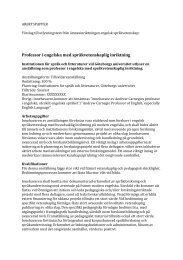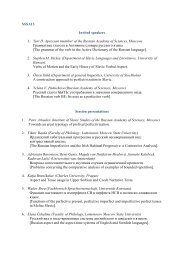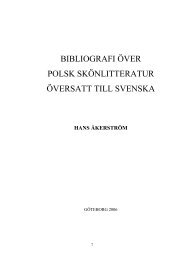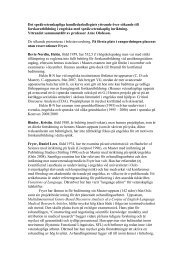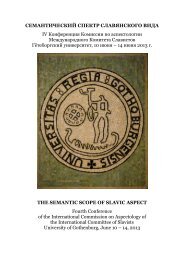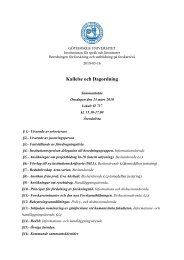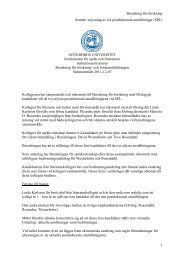George P. Murdock illustrated the process of cultural changes in 1960. ‘<strong>Cultural</strong> change beginswith the process of innovation, the formation of a new habit by a single individual which is subsequentlyaccepted or learned by other members of his society.’ He then further divided innovationinto four groups: variation, invention, tentation and cultural borrowing. He emphasized theimportance of ‘cultural borrowing.’Of all forms of innovation, cultural borrowing is by far the most common and important. Theoverwhelming majority of the elements in any culture are the result of borrowing…for it is doubtfulwhether there is a single culture known to history or anthropology that has not owed at leastninety per cent of its constituent elements to cultural borrowing. 5This statement, based on his careful study of the nature of culture, shows the fact that there isno ‘pure’ culture being formed in isolation. Hybridity is part of culture. Not only culture, but alsolanguage is hybridized. Language is probably the most representative aspect of culture whichtends to show characteristics of cultures.Edward Sapir wrote in 1949, ‘Of all aspects of culture, it is a fair guess that language was thefirst to receive a highly developed form and that its essential perfection is a prerequisite to thedevelopment of culture as a whole.’ 6 According to him, ‘A great deal of the cultural stock in tradeof a primitive society is presented in a more or less well defined linguistic form. Proverbs, medicineformulae, standardized prayers, folk tales, standardized speeches, song texts, genealogiesare some of the more overt forms which language takes as a culture-preserving instrument.’ 7 Itseems culture would not have developed if humans did not possess a language.Just as ‘cultural borrowing’ is universal to all cultures, linguistic ‘borrowing’ is also universalto all languages. Sapir continued, ‘Of the linguistic changes due to the more obvious types ofcontact the one which seems to have played the most important part in the history of language isthe “borrowing” of words across linguistic frontiers. This borrowing naturally goes hand in handwith cultural diffusion.’ 8 One of the essential parts of ‘cultural borrowing’ and ‘word borrowing’is ‘translation.’Taking the meaning of ‘translation’ in a broad sense, George Steiner pointed out,‘Any modelof communication is at the same time a model of trans-lation, of vertical or horizontal transferof significance. No two historical epochs, no two social classes, no two localities use words andsyntax to signify exactly the same things, to send identical signals of valuation and inference. Neitherdo two human beings.’ Therefore, he thought, ‘a human being performs an act of translation,in the full sense of the word, when receiving a speech-message from any other human being… Inshort: inside or between languages, human communication equals translation.’ 9 . Likewise, Peter5 George Peter Murdock, ‘How Culture Changes’, in Harry L. Shapiro, ed. Man, Culture and Society, NewYork: Oxford University Press, 1960, pp. 250, 253-254.6 Sapir, Edward, 1949, Culture, Language and Personality, Berkeley, Los Angeles, London: University ofCalifornia Press, p. 1.7 Sapir, Edward, 1949, Culture, Language and Personality, Berkeley, Los Angeles, London: University ofCalifornia Press, p.18.8 Sapir, Edward, 1949, Culture, Language and Personality, Berkeley, Los Angeles, London: University ofCalifornia Press, p.30.9 Steiner, George, 1975 After Babel: Aspects of Language and Translation, Oxford: Oxford University Press,<strong>Cultural</strong> Translation between Traditions, Languages and Images13
14Newmark thought, ‘translation is the most economical method of explaining one culture’s wayto another’ and ‘translation mediates cultures.’ 10 It seems that translation is an intrinsic part ofhuman activities, without which communication is impossible, and cultures cannot be formed.In other words, culture will not exist if there is no ‘translation.’ If culture is mediated by ‘translation,’then it is inevitably accompanied by adjustment of cultural values, as Lawrence Venutiwrote, ‘Translation, like every cultural practice, involves the creation of values, linguistic andliterary, religious and political, commercial and educational, as the particular case may be. Whatmakes translation unique is that the value-creating process takes the form of an inscribed interpretationof a foreign-language text, whose own values inevitably undergo diminution and revisionto accommodate those that appeal to domestic cultural constituencies.’ 11It short, all translations are cultural, being linguistic translation or ‘translation’ in the broadsense. Therefore, the term ‘cultural translation’ may sound strange, because it can imply a kindof translation that is not cultural. But this shall not surprise us, because ‘translation’ has beenoften mistaken as a simple transmission of words and sentences, regardless of cultural context.However, many translators, according to David Katan, are not aware of the relation betweentranslation and culture. “First, how languages convey meaning is related to the culture. Secondly,though languages can convey concepts from other cultures, people (including translators and interpreters)tend not to realize that their perception (through language) is, in fact, bound by theirown culture.’ 12 Therefore, Hatim and Mason proposed that a translator be placed to identify andresolve the disparity between signs and values across culture. 13Even though all translations are cultural, the term ‘cultural translation’ is still useful becauseit can highlight cultural aspects of a language text. Now we shall see how the so-called ‘culturaltranslation’ takes place at several different levels in a New Zealand novella The Whale Rider.Translating TraditionsThe Whale Rider was published in 1987. It was written by Witi Ihimaera (b. 1944), a prominentNew Zealand writer with Maori and European backgrounds. The story is about how a younggirl proved to be the leader of the Maori tribe. Her great-grandfather, the elder Moari tribe chiefKoro Apirana, thinks that only the male line of the oldest son can inherit the leadership. Whenhis oldest grandson’s first child was born a girl, Koro was deeply disappointed. Because of hisfirm belief in male’s leadership, he has ignored all the signs that indicate the girl’s potential. Heconstantly discourages her, and discriminates against her. But the girl loves him, and wants tohelp him to find the next leader, until she herself becomes the one.The novella is a mixture of Maori founding myth, fantasy and daily life. The myth relates that thepp.47-49.10 Newmark, Peter, 1995, ‘Translation Theory or Spoof’, Lecture delivered at the Trieste University, May.Quoted from David Katan, Translating Cultures: An Introduction for Translators, Interpreters and Mediators,Manchester: St. Jerome Publishing, 1999.11 Venuti, Lawrence ‘Retranslations: The UCreation of Value’ in Fuall, Katherine M., 2004, Translation andCulture, Lewisburg, Pennsylvania: Bucknell University Press, p.25.12 Katan, David, 1999, Translating Cultures: An Introduction for Translators, Interpreters and Mediators,Manchester: St. Jerome Publishing, p.86.13 Hatim, Basil and Ian Mason, 1990, Discourse and the Translator, Harlow, Essex: Longman.Nanyan Guo
- Page 1: Cultural TranslationsProceedings of
- Page 4 and 5: PrefaceThe idea of organizing a wor
- Page 6 and 7: ContentsAcknowledgementIIPrefaceIII
- Page 8 and 9: Literature and Transculturality:Som
- Page 10 and 11: agenda of Herder, which was to figh
- Page 12 and 13: nomenon. However, until long into t
- Page 14 and 15: Tawada’s work appeared in Swedish
- Page 16 and 17: multiple interpretations. Japan is
- Page 18 and 19: Cultural Translation between Tradit
- Page 22 and 23: ancestor of the Maori arrived in Ao
- Page 24 and 25: nal names do not necessarily have.
- Page 26 and 27: One of the functions of ‘cultural
- Page 28 and 29: PRELUDEIn 2003, an original artisti
- Page 30 and 31: planted, adopted and fused with ind
- Page 32 and 33: liest known written clues regarding
- Page 34 and 35: since there are many Asians and Pac
- Page 36 and 37: listening to and evaluating sounds
- Page 38 and 39: Ensemble, and the Moscow Pan-Asian
- Page 40 and 41: temporary Finnish folk music. 29I a
- Page 42 and 43: Although some space for improvisati
- Page 44 and 45: whom have devoted many years to ser
- Page 46: POSTLUDEBy way of conclusion, allow
- Page 49 and 50: IntroductionThe aim of this paper i
- Page 51 and 52: to discuss what role Japan was to p
- Page 53 and 54: I may be allowed henceforth to use
- Page 55 and 56: program was to promote and help stu
- Page 57 and 58: 50different of that of Millán -Ast
- Page 59 and 60: most impracticable people in the ea
- Page 61 and 62: intending to give the Book a quasi
- Page 63 and 64: understood by the West on a time wh
- Page 65 and 66: FUJIWARA Masahiko. (2008) Kokka no
- Page 67: - (2002) Cultural light, political
- Page 70 and 71:
Translation, or better, linguistic
- Page 72 and 73:
one may not expect anything other t
- Page 74 and 75:
as Murakami opts for a globalized v
- Page 76 and 77:
market. 17 Another indispensable to
- Page 78 and 79:
(This is part of my doctoral thesis
- Page 80 and 81:
elieve advances man’s progress he
- Page 82 and 83:
ender the New Testament into Japane
- Page 84 and 85:
a synonym for kami. The latter is a
- Page 86 and 87:
The American school text is in the
- Page 88 and 89:
Willson Reader 46 T73 47I will not
- Page 90 and 91:
Gentlzer, Edwin & Tymoczko, Maria 2
- Page 92 and 93:
Tea ceremony or tea cult?Translatin
- Page 94 and 95:
Company (VOC), men came from differ
- Page 96 and 97:
H. Stolpe gathered items in Japan f
- Page 98 and 99:
simple presentations had negative i
- Page 100 and 101:
theticism, with its manifold bearin
- Page 102 and 103:
Kumakura, Isao (1980) 近 代 茶
- Page 104 and 105:
1. Introduction and aim of the pape
- Page 106 and 107:
main character and the caller doesn
- Page 108 and 109:
not” and ”at present” that ha
- Page 110 and 111:
match this name, a sea as artificia
- Page 112 and 113:
I John Gabriel BorkmanHenrik Ibsen
- Page 114 and 115:
his dream during the 1870s, when ca
- Page 116 and 117:
make a decision. But it turns out t
- Page 118 and 119:
Ôgai’s change of translation str
- Page 120 and 121:
Behind every utterance lies two mot
- Page 122 and 123:
a large group of persons be gathere
- Page 124 and 125:
The “Territory of Translation”
- Page 126 and 127:
八 十 日 間 世 界 一 周 :
- Page 128 and 129:
heuristic tools, especially conside
- Page 130 and 131:
Left: Photo of Kawashima Chūnosuke
- Page 132 and 133:
Burlington Gardens is in London (Ro
- Page 134 and 135:
門 アリ 入 リテ 見 レバ
- Page 136 and 137:
scene seems to be merely one of man
- Page 138 and 139:
Niwa Jun’ichirō’s Spring Tale
- Page 140 and 141:
The text is full of detailed descri
- Page 142 and 143:
where the narrative voice does not
- Page 144 and 145:
The reason the “territory of tran
- Page 146 and 147:
Translating the Trip Around the Wor
- Page 148 and 149:
ForwordI have been working on my do
- Page 150 and 151:
clining though. By the end of 1980
- Page 152 and 153:
幸 い 神 の 怒 りは 鎮 ま
- Page 154 and 155:
The Public Sphere as Deliberation o
- Page 156 and 157:
and absence of hierarchy would have
- Page 158 and 159:
was used much like we would use “
- Page 160 and 161:
outcasts and bandits - were suppose
- Page 162 and 163:
cal sense, the arena where particip
- Page 164 and 165:
society” and in which “there wa
- Page 166 and 167:
sic formulations, the public sphere
- Page 168 and 169:
はじめに日 本 統 治 下 の
- Page 170 and 171:
似 地 一 下 一 下 拽 那 鼻
- Page 172 and 173:
ということから、 古 丁
- Page 174 and 175:
の「 序 」で、 大 東 亜
- Page 176 and 177:
3.1 翻 訳 と 満 洲 国 語 政
- Page 178 and 179:
取 り 入 れを 主 張 する
- Page 180 and 181:
文 化 の 翻 訳 としての「
- Page 182 and 183:
史 性 にも 留 意 すべきだ
- Page 184 and 185:
て、 渦 巻 きよりほかは
- Page 186 and 187:
変 わらないということも
- Page 188 and 189:
訳 語 と 新 語 から 見 る
- Page 190 and 191:
しは「 無 為 」や「 本 性
- Page 192 and 193:
思 想 を 基 礎 として、
- Page 194 and 195:
って「 物 理 上 哲 学 」
- Page 196 and 197:
し、まさにはこの 時 期
- Page 198 and 199:
意 譯 : 理 學 、 性傅 汛
- Page 200 and 201:
柴 田 昌『 增 補 訂 正 英
- Page 202 and 203:
一 八 七 七 年 、 文 部 省
- Page 204 and 205:
日 中 友 好 の 象 徴 「 鑑
- Page 206 and 207:
と 指 摘 した。成 吉 思
- Page 208 and 209:
をあげている。さらにま
- Page 210 and 211:
に 請 ひて 出 家 を 求 む
- Page 212 and 213:
この 時 奉 請 の 十 師 等
- Page 214 and 215:
歴 史 小 説 『 天 平 の 甍
- Page 216 and 217:
点 」が 生 じたと 指 摘
- Page 218 and 219:
まず、 昨 今 、 活 発 に
- Page 220 and 221:
2、 従 来 の 比 較 文 学 (c
- Page 222 and 223:
普 遍 理 論 を 適 用 し、
- Page 224 and 225:
ス・テグネル(Esaias Tegnér,
- Page 226 and 227:
に 満 ちる「 生 命 」に
- Page 228 and 229:
う 形 をとって 展 開 した
- Page 230:
学 が 大 学 で 展 開 して



